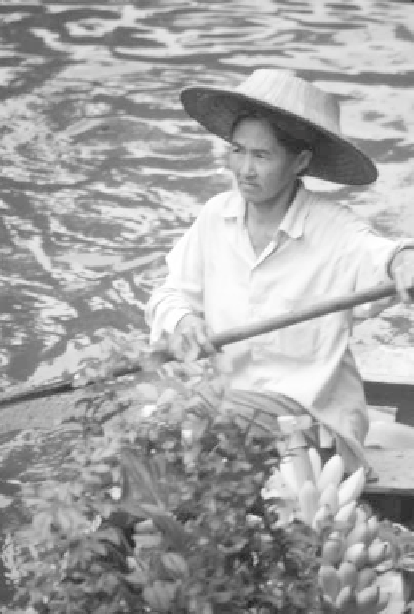Geography Reference
In-Depth Information
with the major artery—the Chao Praya (Figure 15-12).
Now many of the
khlongs
have been paved over and
quicker boat traffic has given way to slower vehicle
traffic.
With development so concentrated in the BMR, the
question is this: Is Thailand a newly industrializing
country or is Bangkok a newly industrializing city? It
does appear that Thailand is more of a metropolitan tiger
than a national one.
Vietnam: Baby Tiger
“T “Two baskets of rice separated by a bamboo pole.” This is
Vietnam—the densely populated Red River Delta in the
north strung by 1,000 miles (1,610 km) of mountains
and a narrow coastal strip to the watery world of the
Mekong Delta in the south. On these two rich, alluvial
plains live two-thirds of the Vietnamese population, now
numbering 87.3 million (Figure 15-13).
Eighty percent of the people in Vietnam are eth-
nic Vietnamese. In addition, there are at least 50 mi-
nority groups. Some minorities are identifiable by
their religious affiliation. Roman Catholics are the
largest group. At independence in 1954, there were
about 2 million. When Vietnam was divided later into
two zones, about two-thirds of the 900,000 who left
the north were Catholic. Another group is the Cao
Dai, with its headquarters in Tay Ninh Province near
Ho Chi Minh City . Cao Dai means “high tower” and is
a mix of Buddhist, Christian, Confucian, and Taoist
beliefs.
Although the population is dominated by the ethnic
Vietnamese, the presence of these other groups has made
it difficult for any government to create a centralized and
highly integrated society . Moreover, regional differences
are strong among the northerners, southerners, and the
central Vietnamese. Currently , the Communist regime is
attempting to reduce these dichotomies by integrating
southerners into the more regimented system of the
north. Moreover, modernization is moderating differ-
ences throughout the country .
Figure 15-12
Bangkok is famous for its
khlongs.
Many people live in stilt-
houses along these canals, and floating markets are held in many
areas.
Photograph courtesy of B. A. Weightman.
have been installed, but they only reach limited areas of
the city . Motorcycles, buses, taxis, and trucks comprise
the bulk of the traffic. Buses, which account for a mere
one percent of the traffic, contribute more than half of
the pollution.
Even though masses of vehicles such as buses con-
tinue to belch toxic, black smoke, Bangkok has cleaned
up its act to a considerable degree. Officials convinced oil
companies to produce cleaner fuel, used higher taxes to
phase out the once-ubiquitous two-stroke motorcycles,
and converted all taxis to run on clean-burning, liquefied
petroleum gas. Having no emissions standards before
1992, Thailand now has controls based on European
standards. Bangkok, once an icon for smog, has emerged
as a role-model for Asia' s pollution-choked capitals,
boasting considerably cleaner air than Jakarta, New
Delhi, Beijing, and Shanghai.
Bangkok is called the Venice of Asia because of its
khlong
(canal) system linking various parts of the city
ORIGINS AND CHINESE INFLUENCE
It is possible that the ancestors of the Vietnamese origi-
nated in southern China, but they first appear in history
as
homo erectus
in the Red River Delta (T (Tonkin region) at
the same time as Peking and Java Man, about 500,000
years ago. Available evidence supports the fact that they
had mastered primitive agricultural techniques as early


















Search WWH ::

Custom Search